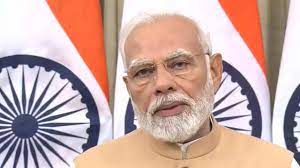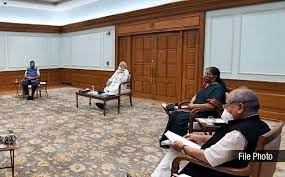
Current Affairs is the most important area in all competitive exams. But the difficulty level is very high. That’s why; many aspirants get confused, how to select Current Affairs for Preparation of Competitive Examination? In this Post, Daily Current Affairs 14 June 2023, we have tried to cover each and every point and also included all important facts from National/ International news that are useful for upcoming competitive examinations such as UPSC, SSC, Railway, State Govt. etc.
So, here is the Top News of the Day for 14 June 2023 to help you prepare the Latest Current Affairs part. After reading this section, you can successfully attempt Current Affairs Quiz.
Current Affairs for Competitive Exam – 14 June 2023
World Blood Donor Day 2023: Date, Theme, Significance and History

World Blood Donor Day 2023
Every year on June 14, World Blood Donor Day is commemorated to express gratitude to altruistic voluntary blood donors and to honour the essence of life and humanity. This event provides an important platform to thank and recognise voluntary blood donors around the world for their generous contributions of blood, while also emphasising the necessity of ensuring universal access to safe blood transfusion.
Theme for World blood Donor Day 2023
The World Blood Donor Day 2023 slogan or theme is “Give blood, give plasma, share life, share often.” The theme highlights the importance of giving blood or blood plasma regularly to create a safe and sustainable supply of blood and blood products that can be always available, all over the world, so that all patients in need can receive timely life saving treatment.
Host country for World Blood Donor Day 2023
The host country for the global event of World Blood Donor Day 2023 is Algeria through its National Blood Transfusion Service.
Significance of World Blood Donor Day 2023
The significance of blood donation is not only to save the lives of thousands of individuals who are deprived of life, but also to save the lives of many more who are afflicted with various diseases and assist them in fighting various ailments. Blood donation does not cause weakness. As per published literature, Blood volume (plasma) is replenished within 24-48 hours. Red blood cells are replenished in 3-4 weeks in healthy adults after donation.
History of World Blood Donor Day
World Blood Donor Day was created by the World Health Organisation (WHO) in 2004. It was declared as an annual global event during the 58th World Health Assembly in 2005 with the goal of raising awareness about the importance of blood donation.
The origins of blood donation can be traced back to ancient times. In recorded history, the noteworthy contributions of Richard Lower, an English physician, stand out. Lower’s groundbreaking work on blood transfusion and the functioning of the cardiopulmonary system, as documented in his book ‘Tractatus de Corde,’ remains highly influential. He was the first to delve into the scientific aspects of blood donation, conducting successful blood transfusions between two dogs without any notable adverse effects.
GSITI Hyderabad Receives “Athi Uttam” Accreditation

Accreditation of Geological Survey of India Training Institute (GSITI) by NABET
The National Accreditation Board of Education and Training (NABET) has accredited the Geological Survey of India Training Institute (GSITI), which is part of the Ministry of Mines. This recognition is a testament to the institute’s commendable services and the high standards it upholds in the realm of earth science training. A team comprised of representatives from the Capacity Building Commission (CBC), NABET, and the Quality Control of India completed the evaluation. They thoroughly inspected the institute’s various levels of standard operating procedures and methodologies. Subsequently, GSITI was granted the Certificate of Accreditation with the distinguished grading of “Athi Uttam.”
Overview of GSITI and its Regional Training Divisions and Field Training Centers
- GSITI was founded in 1976 and is based in Hyderabad. It is run by the Ministry of Mines and has six Regional Training Divisions (RTDs) in Hyderabad, Nagpur, Jaipur, Lucknow, Kolkata, and Shillong. There are also four Field Training Centres (FTCs) in Chitradurga, Karnataka, Raipur, Chhattisgarh, Zawar, Rajasthan, and Kuju, Jharkhand.
- These centers were established in line with the Ministry of Mines’ vision to provide various trainings in geology to professionals, teachers, researchers, and students in the field of geoscience. GSITI serves as a national training facility, offering training and capacity building programs to a wide range of stakeholders, including central and state departments, public sector undertakings (PSUs) such as MECL, ONGC, OIL, NMDC, national academic institutions like IITs, central universities, colleges, and other educational institutions.
- The institute conducts regular courses on remote sensing under the NNRMS Programme, which is sponsored by the Indian Space Research Organization (ISRO). With its international reputation, GSITI also provides training to participants from developing nations through the ITEC programme, sponsored by the Ministry of External Affairs. To date, professionals from 75 nations have received training at the institute.
Specialized Training Courses Offered by GSITI
GSITI provides domain-specific and terrain-specific training programmes through its Hyderabad headquarters, as well as Regional Training Divisions (RTDs) and Field Training Centres (FTCs) located around the country. These programs are designed to enhance competencies in various domains. Participants can acquire skills in mapping techniques for different terrains, including the Himalayas, as well as exploration methods to target mineralized zones such as Gold, Diamond, Copper, Lithium, Rare Earth Elements (REE), Iron, and Manganese.
Other courses cover topics such as photo-geology and remote sensing, geographic information systems, petrology, geochronology, geophysics, analytical methods in chemistry, environmental and urban geology, and natural hazard mitigation. Furthermore, GSITI provides seminars focused at improving employees’ functional competencies. The institute also recognizes the importance of behavioral competencies and ensures that relevant topics are included in the training curriculum for officials.
Important takeaways for all competitive exams:
- Geological Survey of India Founder: Thomas Oldham;
- Geological Survey of India Founded: 4 March 1851;
- Geological Survey of India Parent organization: Ministry of Mines;
- Geological Survey of India Headquarters: Kolkata, West Bengal, India.
“Hamari Bhasha, Hamari Virasat” On 75th International Archives Day

On the occasion of the 75th International Archives Day, the National Archives of India organised the exhibition “Hamari Bhasha, Hamari Virasat.”
About the news
Smt. Meenakashi Lekhi, Minister of State for Culture, launched the exhibition “Hamari Bhasha, Hamari Virasat” as part of the Azadi Ka Amrit Mahotsav to commemorate the 75th International Archives Day at the National Archives of India in New Delhi.
Significance
- International Archives Day commemorates the treasured heritage of India’s linguistic diversity as a Nation.
- It increases awareness about the significance of records and archives in establishing people’s rights and identities.
- India is one of the four most linguistically diversified countries in the world with 788 languages spoken in India alone.
Whats new this year
- On the occasion of the 75th International Archives Day, the National Archives of India has made available the Gilgit Manuscripts, which were written between the 5th and 6th centuries CE and are India’s oldest surviving manuscript collection.
- It contains documents written on pieces of inner layer of the bark of birch trees which were found in Kashmir region and contain both canonical and non-canonical Jain and Buddhist works that throw light on the evolution of many religious-philosophical literature.
About National Archives of India
- The National Archives of India was established on 11 March 1891 at Kolkata (Calcutta) as the Imperial Record Department
- It possesses around 72,000 manuscripts on the premises and in the process of digitization.
- It is also the nodal agency for the implementation of the Public Records Act, 1993 and Public Record Rules, 1997.
EPFO Is Set To Be An Affiliate Member Of ISSA And Gain Worldwide Recognition

The Employees’ Provident Fund Organisation (EPFO) is poised to move from associate member to affiliate member of the International Social Security Association (ISSA). This will enable the EPFO to gain access to professional guidelines, expert knowledge, services, and support for its pension subscribers.
EPFO is set to be an affiliate member of ISSA: Key Points
- The retirement fund body, EPFO, has received approval from its central board of trustees to upgrade its membership status with ISSA from associate member to affiliate member.
- However, based on the number of pension subscribers, annual membership fees will rise dramatically from 10.34 lakh to 2.14 crore.
- According to the minutes of the CBT meeting held in March, only the Coal Mines Provident Fund Organisation from India is currently an ISSA affiliate member.
What benefits will EPFO have after becoming a member of ISSA?
- The EPFO will gain international recognition, by becoming an affiliate member of ISSA.
- The opportunity to endorse candidates for ISSA leadership posts, become a member of its steering committee, and conduct regional meetings as a complete administrative social security institution.
- However, affiliate membership comes at a cost of ₹2.14 crore compared to ₹10.34 lakh for associate membership.
- The EPFO has a corpus of over ₹12 lakh crore and a net subscriber base of 60 million.
SIDBI Launches Evolve Mission With Niti Aayog

SIDBI Launches EVOLVE Mission with NITI Aayog
Credit and finance for MSMEs: In collaboration with the NITI Aayog, World Bank, Korean-World Bank, and Korean Economic Development Cooperation Fund (EDCF), the Small Industries Development Bank of India (SIDBI) announced the launch of mission EVOLVE (Electric Vehicle Operations and Lending for Vibrant Ecosystem) to provide financial support for micro, small, and medium-sized enterprises (MSMEs) involved in the electric vehicle space.
What will EVOLVE Mission offer?
- The initiative will offer affordable commercial financing for EV loans, including the introduction of telematics to lower financing costs and provide financial data.
- The mission aligns with SIDBI’s goal of supporting India’s 30% EV penetration target by 2030 (EV30@30).
- In April, SIDBI launched a pilot programme dubbed Mission 50,000-EV4ECO to assist MSMEs in obtaining loans to purchase EVs for commercial use.
EVOLVE Mission Aim:
The mission aims to fund 50,000 EVs, and sanction letters have been delivered to companies, such as Aristo Securities and Mufin Green Finance, to bring 5000 to 2/3-wheel EVs on the road shortly.
- The SMEV reported that EV sales had reached over 1 million in India during the fiscal year 2022-23, with two-wheelers dominating the percentage share of 62%.
₹1.2 Trillion Released As Third Tax Devolution To States By Govt

₹1.2 Trillion Released as Third Tax Devolution to States by Govt
The Ministry of Finance declared that the Central government had given the state governments the third installment of tax devolution totaling Rs. 1,18,280 crore. Andhra Pradesh received $4,787 million, while Arunachal Pradesh received $2,078 million. Assam, Bihar, Chhattisgarh, and Gujarat received respectively 3,700 crore, 11,897 crore, 4,030 crore, and 4,114 crore.
What are the Key Features of the fund allocation?
- This amount surpasses the monthly devolution of ₹59,140 crore and reveals the government’s dedication to supporting the fiscal needs of state governments.
- The additional advance instalment offered to states would facilitate capital investment, support development and welfare-related expenditures, and assure resource availability for important projects and schemes.
What is the criteria to allocate funds to the state?
- The allocation of funds to each state was based on a formula that considers population, area, and fiscal capacity. The state-wise distribution of the net proceeds of union taxes and duties for June 2023 reveals the amounts received by each state.
Indian Film ‘When Climate Change Turns Violent’ Wins Who Award

A documentary titled ‘When Climate Change Turns Violent has won a special prize in the ‘Health for All’ category at the 4th Annual Health for All Film Festival held at the World Healtth Organization headquarters in Geneva. Vandita Saharia of Rajasthan directed the documentary. She was the only winner who was Indian.
The festival, attended in person and online by actors, producers and public figures, saw winning films announced for seven different categories, while four films received special mention by the jury. A panel of eminent professionals, artists, and activists, including noted actors Sharon Stone and Alfonso Herrera, choreographer Sherrie Silver, climate activist Sophia Kianni, and media personality Adelle Onyango, judged the films. The distinguished panel was joined by senior United Nations officials and WHO staff.
List of films awarded:
- UHC “Grand Prix”: “Jonathan’s Miracle Feet” – Sierra Leone / Disability, clubfoot
Directed by Mamihasina Raminosoa and Nantenaina Rakotondranivo from Madagascar for the NGO Miracle Feet / Documentary – Duration 3’19’’ - Health Emergencies “Grand Prix”: “Nurses facing Covid / Na Lihna de Frente” – Brazil / COVID-19 and access to care Directed by Klimt Publicidade and the institution Conselho Federal de Enfermagem – Cofen – From Brazil / Documentary – Duration 8’
- Better Health and Well-being “Grand Prix”: “One in 36 Million: Story of Childhood Lead Poisoning in Bangladesh” – Environmental health Directed by Mitali Das and Arifur Rahman (Bangladesh) for the NGO Pure Earth Bangladesh Documentary – Duration 6’32’’
- Special Prize Climate Change and Health Film: “When climate change turns violent” – Global / Gender based violence and climate change Directed by Vandita Sariya (India) / Documentary – Duration 4’32’’
- Special Prize Sexual and Reproductive Health and Rights Film:“Vulvo and Dynia” – Israel / Vulvodynia Directed by Dina Stescovich (Israel) / Fiction – Duration 4’13’’
- Student Film Prize:“Gasping for life” – Germany / Mental health, screens addiction, anxiety, depression Directed by Su Hyun Hong (Germany) / Animation – Duration 8’
- Special Prize Very Short Film:“Mirrors” – Sweden / Mental health, depression Directed by Paul Jerndal (Sweden) / Fiction – Duration 3’
ADB, India Sign $130 Million Loan To Promote Horticulture In Himachal Pradesh

The Indian government and the Asian Development Bank (ADB) have inked a $130 million loan deal to assist efforts in Himachal Pradesh targeted at raising agricultural production, expanding irrigation access, and promoting horticulture agribusinesses. The project aims to enhance farmers’ income and resilience to climate change in seven districts of the state.
Improving Farmers’ Livelihoods:
The project interventions seek to benefit approximately 15,000 farm households across the districts of Bilaspur, Hamirpur, Kangra, Mandi, Sirmour, Solan, and Una. Many of these households have either stopped farming or reduced their farming areas due to a lack of irrigation facilities and crop damage caused by wild and stray animals.
Enhancing Irrigation Infrastructure:
One of the key focuses of the project is to improve on-farm irrigation and water management in around 6,000 hectares of farmland. This will be achieved through the rehabilitation or construction of new irrigation schemes. The project will also strengthen the capacity of Water Users’ Associations (WUAs) for micro-irrigation management. The initiative will be a joint effort between the state’s Jal Shakti Vibhag (Water Resources Department) and the Department of Horticulture (DOH).
Promoting Horticulture Agribusinesses:
In addition to irrigation improvements, the project aims to create an ecosystem that enhances farmers’ access to subtropical horticulture markets. Farmers will be organised into cluster-wide and district-wide Community Horticulture Production and Marketing Associations (CHPMAs). This approach will facilitate collective marketing and value addition activities, benefiting farmers by providing better market linkages and improved bargaining power.
Increasing Resilience to Climate Change:
The project recognizes the challenges posed by climate change and seeks to enhance farmers’ resilience. By improving irrigation facilities and promoting climate-resilient agricultural practices, the project aims to minimize the adverse impacts of climate change on agriculture. This will enable farmers to continue farming and increase their incomes sustainably.
SIPRI’S Findings On Nuclear Arsenals: China’s Expansion, India and Pakistan’s Growth, and Global Trends

The Stockholm International Peace Research Institute (SIPRI) recently released its annual Yearbook, providing valuable insights into the state of global nuclear arsenals. This article outlines SIPRI’s important results, with a focus on China’s nuclear buildup, India and Pakistan’s increasing arsenals, and global trends.
China’s Nuclear Arsenal:
SIPRI’s assessment reveals that China has significantly increased its nuclear arsenal in contrast to its official position of maintaining the minimum necessary for national security. The report suggests that China’s long-term plans for modernization and expansion have contributed to the growth. China’s nuclear weapons climbed from 350 in January 2022 to 410 in January 2024, according to SIPRI estimates. Furthermore, SIPRI warns that if China continues on this trajectory, it could potentially possess as many nuclear weapons as the United States or Russia by the end of the decade, depending on its strategic decisions.
India and Pakistan’s Nuclear Arsenals:
SIPRI’s Yearbook also highlights the expansion of India and Pakistan’s respective nuclear arsenals. Both countries have been introducing and developing new nuclear delivery systems. According to the paper, Pakistan remains the principal focus of India’s nuclear deterrence policy. However, India has prioritised long-range weaponry, especially ones capable of reaching areas inside China. SIPRI notes that India has completed its nuclear triad by deploying two new ballistic missile nuclear submarines and upgrading its ballistic missiles. Notable additions to India’s arsenal include a submarine-launched intermediate-range ballistic missile and the Agni Prime, which is planned to replace older Agni missiles in the 1000-2000 km range, as well as the Agni-5, which has a range of over 5000 km.
Global Nuclear Inventory and Modernization:
The assessment by SIPRI emphasises that the nine nuclear-armed powers, which include the United powers, the United Kingdom, Russia, France, China, India, Pakistan, North Korea, and Israel, are continuing to modernise their nuclear arsenals. Several of these states deployed new nuclear-armed or nuclear-capable weapons systems in 2022. The global inventory of estimated warheads stood at approximately 12,512, with around 9,576 warheads held in military stockpiles for potential use. Notably, the United States and Russia accounted for 90% of the total warheads, although their arsenal sizes remained relatively stable in 2022.
Impact of the Invasion of Ukraine:
SIPRI warns that the transparency surrounding nuclear warheads possessed by Russia and the United States has declined in the aftermath of the conflict in Ukraine. The U.S.A. suspended its bilateral strategic stability dialogue with Russia following the invasion, prompting Russia to suspend its participation in the New START Treaty. This treaty, which expires in 2026, imposed limits on the nuclear strategic forces of both countries. Discussions on a follow-up treaty have also been suspended. However, as of January 2023, SIPRI concludes that the deployed strategic forces of both nations remain within the limits set by the New START Treaty.
Uruguay Beat Italy 1-0 To Win Maiden Fifa U-20 World Cup

Uruguay beat Italy 1-0 to win its first FIFA U-20 World Cup 2023. The Celeste’s victory ends a streak of four consecutive wins of European teams in the tournament.
Luciano Rodríguez scored the winning goal in the 86th minute with a header from close range, giving Uruguay a much-deserved victory after an entire match of dominance against Italy. Earlier, debutant Israel beat South Korea 3-1 to secure third place in the same stadium in La Plata.
India And UAE Target $100 Billion Non-Oil Trade By 2030; Set Up Councils to Facilitate FTA Implementation

India and the United Arab Emirates (UAE) have set a lofty goal of increasing non-oil bilateral trade from USD 48 billion to USD 100 billion by 2030. The decision was reached during the first meeting of the Joint Committee of India-UAE Comprehensive Economic Partnership Agreement (CEPA). Both countries intend to quadruple non-petroleum trade in the next seven years, highlighting the need of expanding economic relations beyond the oil industry.
Strengthening Economic Ties:
The Joint Committee of India-UAE CEPA agreed to establish various committees, sub-committees, and technical councils to effectively implement the provisions of the trade agreement. These committees will concentrate on essential issues such as goods trade, customs facilitation, origin regulations, sanitary and phytosanitary measures, trade remedies, investment facilitation, and economic cooperation.
Enhancing Trade in Services:
To promote trade in services, a new sub-committee will be formed to handle matters related to this sector. Both countries have also decided to exchange services trade data on a quarterly basis. This initiative aims to boost collaboration and expand opportunities in areas such as MSMEs, startups, women entrepreneurs, and the services sector.
India-UAE CEPA Council:
The India-UAE CEPA Council will act as a platform for both governments and export-oriented commercial sectors to facilitate CEPA implementation. This council will raise awareness, form alliances, and organise business events in India and the United Arab Emirates. It will also focus on supporting MSMEs, startups, women entrepreneurs, and participants in the services sector.
Collaboration in the Petroleum Sector:
While diversifying their trade relationship, India and the UAE emphasized the importance of the petroleum sector. India, being a significant importer of petroleum products, requested the UAE to encourage their companies to source more refined products from India. The UAE, as a large consumer of refined products, also expressed interest in expanding trade in this area.
Investments and Growth Opportunities:
The UAE’s Abu Dhabi Investment Authority (ADIA) is set to establish a presence in India’s GIFT city, which will further accelerate inward investments into India. Investors from the UAE are keen to explore opportunities in sectors such as energy, emerging technologies, skills and education, food, healthcare, defense, and startups. This reflects the growing interest in India’s robust investment climate.
Positive Impact of CEPA:
The CEPA between India and the UAE has already begun to bear fruit. Bilateral non-oil commerce increased by 5.8% in the first year after its introduction, reaching USD 50.5 billion. Despite the global decline in trade during Q3 and Q4 of 2022, the India-UAE partnership demonstrated resilience and contributed to economic growth. In the first quarter of the current year, total bilateral trade reached USD 13.2 billion, representing a 16.3% increase compared to the previous quarter.





